This easy, all-in-one homemade biltong recipe results in a delightfully spiced, and oh-so-moreish snack!
Biltong is a dried, cured meat that originated in Southern Africa. It can be made from a variety of types of meat such as beef (which is the most common variety you will find in South Africa), as well as game meats such as kudu or ostrich.
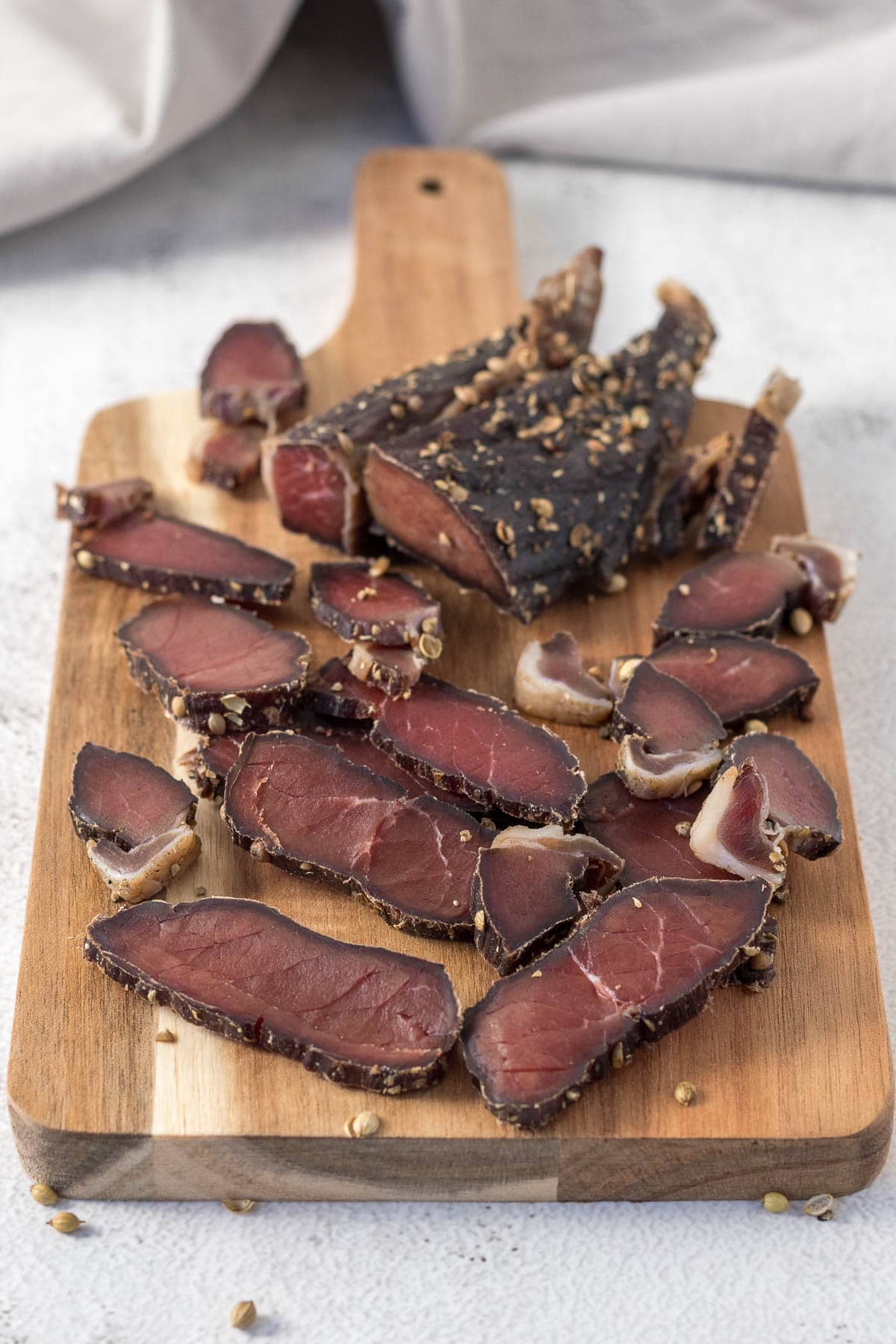
Jump to:
The word "Biltong" is most likely derived from the Dutch words bil which means "buttock" and tong which means strip.
The buttock refers to the "round" cut of beef, which is the cut of beef that, is also known as the "topside" and "silverside".
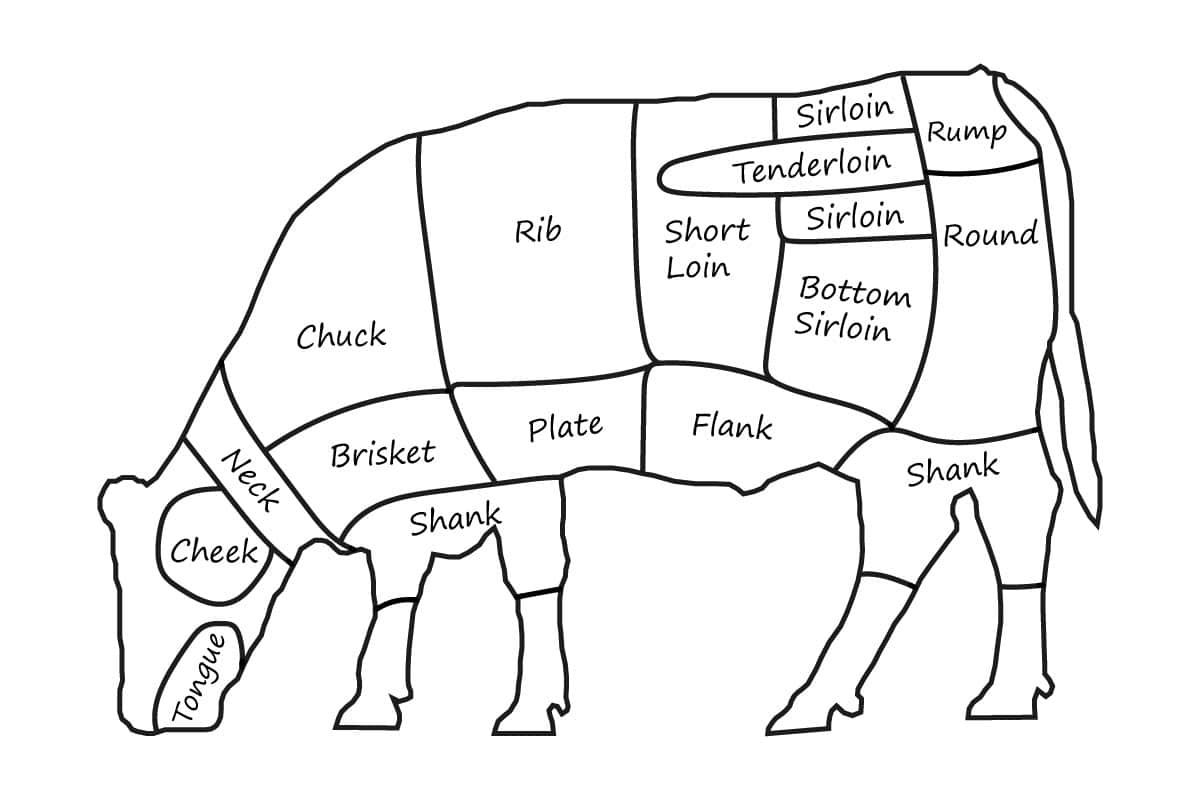
Eating Biltong
Walking into a butchery in Southern Africa and asking for biltong you will probably be met with the following questions:
- Wet, medium or dry? This refers to how dry you want the biltong. But is also influenced by how quickly a butchery sells its biltong. More popular establishments won't have time to dry the biltong beyond "medium".
- Sliced or not sliced? Biltong can be sold as strips or can be sliced in the butcher. Most have specific slicers reserved just for biltong.
- If sliced - thin or thick?
- How much fat? Some people enjoy really fatty pieces and some people only like the really lean cuts of meat. Keep in mind that game biltong usually has very little fat.
- Would you like extra biltong spice on that?
But then how do you eat biltong? Well, it's usually eaten as slices for a snack. But biltong can also be added to stews or potjies (a biltong potjie is super delicious!), savoury muffins, and bread, and can even be used to make sandwiches.
Making Biltong Traditional Way
Traditionally biltong was made during the cold dry Highveld winters. The Highveld refers to the inland plateau that consists of the Free State, Gauteng and portions of the Eastern Cape, Northern Cape, North West, Limpopo and Mpumalanga.
The strips of beef or venison would be sliced against the grain and cured with salt and spiced, before being hung in a cool dry area to dry completely. The cold dry air of the winter months of the Highveld allowed the meat to dry out quickly, with a lower risk for the growth of mould and bacteria.
The Modern Way
Today, biltong is made throughout the year, using a variety of methods. Many butchers across the country will have a space dedicated to making and drying biltong. Each butcher will generally have their preferred method of curing the meat and drying the meat.
Because biltong is now throughout the year, many will rely on fans to blow on the meat strips to enhance the drying process.
Typically homemade biltong is dried in a biltong cabinet. The Mellerware Biltong King is one of the more popular commercial cabinets you can buy. However, if you are looking into making your own cabinet I highly suggest visiting Reddit's Biltong Community.
This community of 13,000 plus members not only discuss different biltong recipes, but here you will also get a feel for homemade biltong cabinets. These can be made out of wood, or even a plastic tub, and consist of a light bulb and a computer fan for ventilation.
Ingredients
Here are some notes on the ingredients used in this recipe. Please see the recipe card for quantities.
Beef - typically the beef used for biltong comes from the round (as seen in the diagram above), this is also known as silverside or topside. However tenderloins, sirloin and rump can also be used.
Vinegar - we tested both malt and red wine vinegar, both make really good biltong. The malt vinegar has a more neutral flavour while the red wine vinegar really stands out as a separate flavour profile.
Flakey Sea Salt - we tested 2%, 2.5% and 3% salt (w/w) during our recipe development and highly recommend falling somewhere in the 2.25-2.5% salt. We also tested coarse salt vs flakey sea salt and flakey sea salt won. Why? because it grinds down easier in the mortar and pestle which lends to an evenly seasoned piece of meat.
Note - if you are looking for high-quality local sea salt in New Zealand, I highly recommend Opito Bay Salt!
Coriander and peppercorns for that deliciously seasoned flavour that we know and love.
Brown Sugar for the vinegar wash adds a touch of caramelised flavours. We did also test a batch with honey, but I found there was a definite hint of honey (which is not a bad thing!). But if using honey then stick to malt vinegar!
Worchestershire sauce to further deepen the flavours.
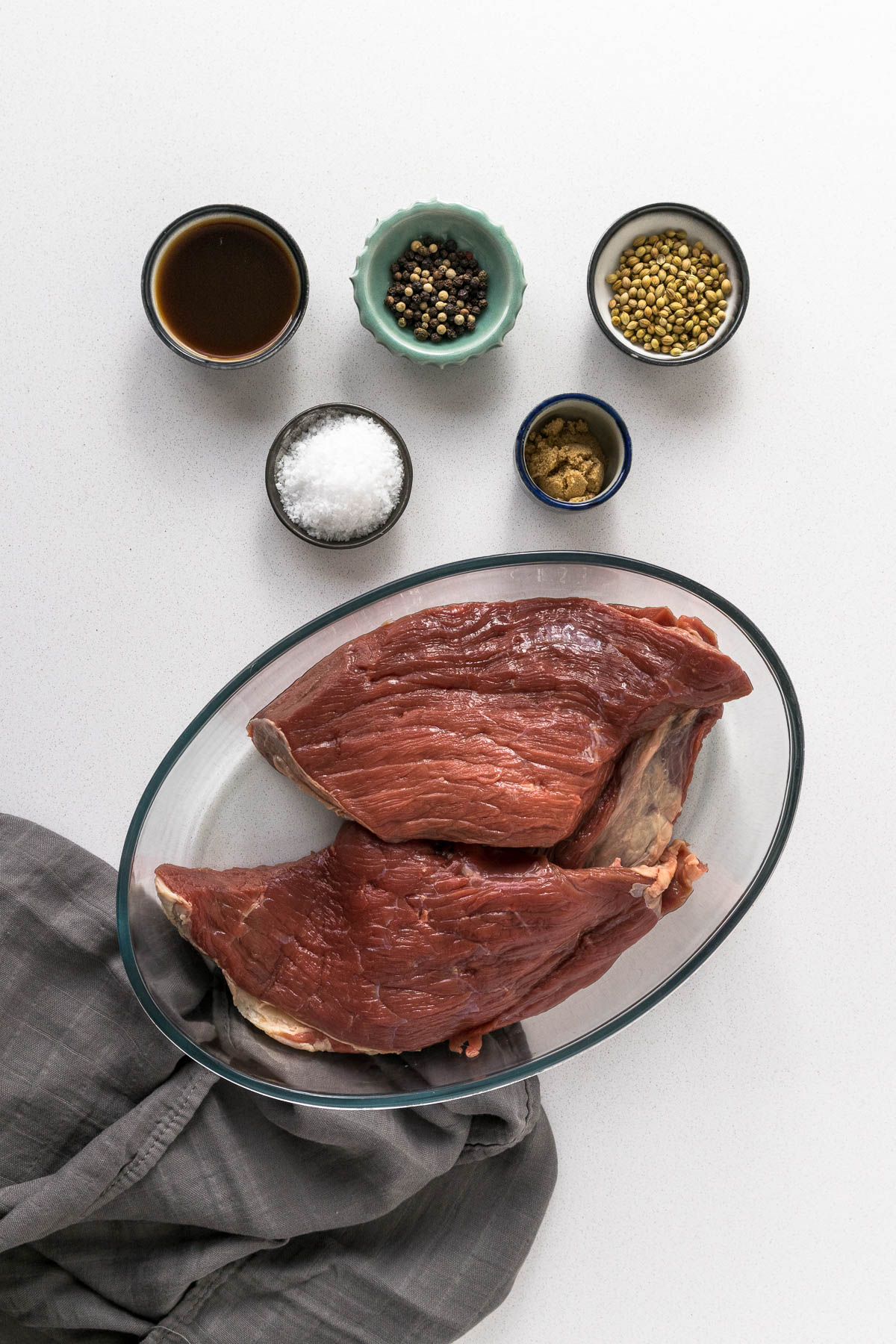
Making Biltong
Step 1 - Toast the coriander and black pepper until browning, fragrant and smoking a tiny bit in a dry pan.
Step 2 - Place the coriander, pepper and sea salt into a mortar and pestle and grind until about 50% of the coriander, and black pepper are mostly powder-like. Set aside.
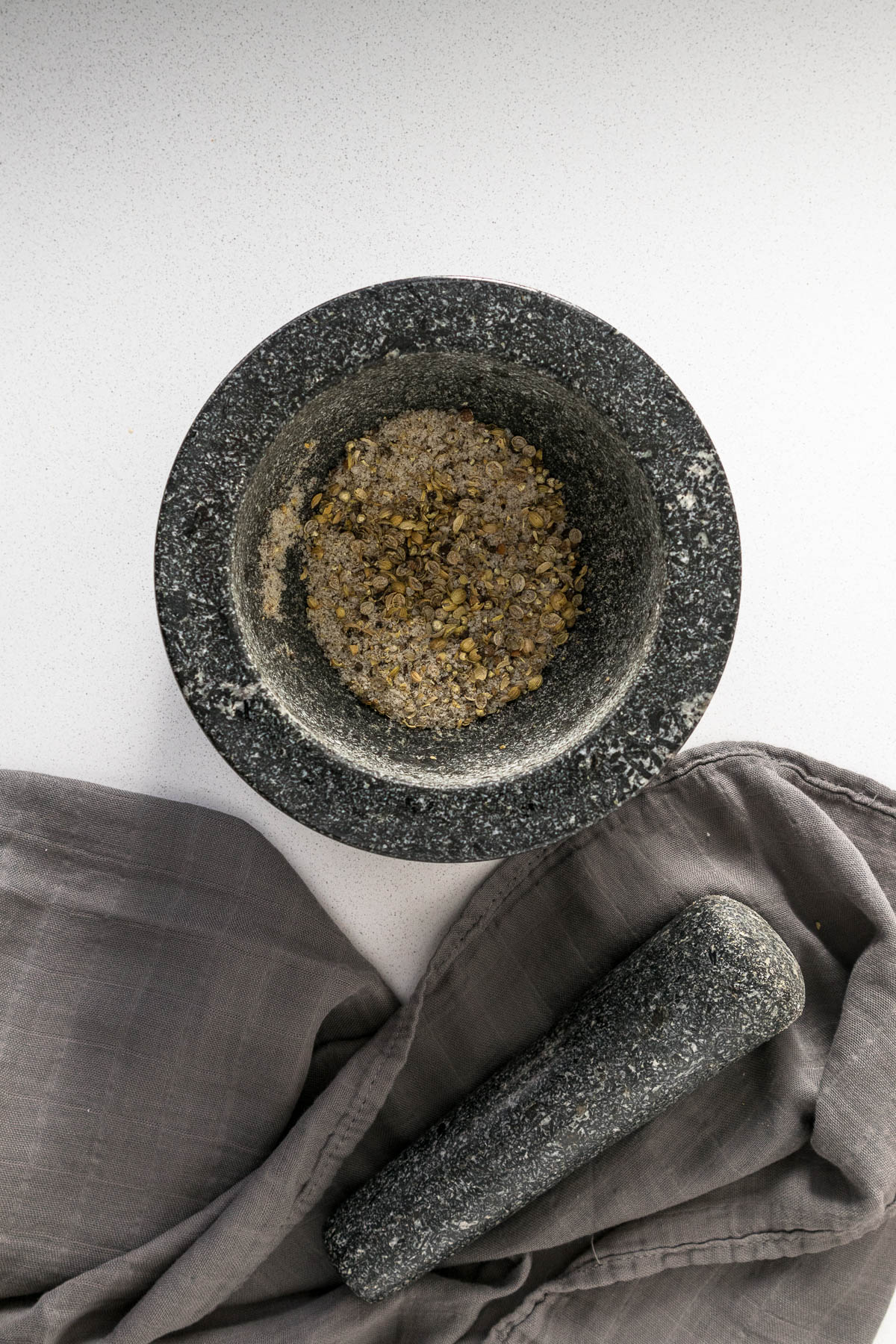
Step 3 - In a small bowl, combine the vinegar, Worcestershire sauce and sugar. Stir until the sugar has dissolved. Set aside.
Step 4 - Cut the meat along the grain into 3cm thick strips.
NOTE - see how to make biltong in a dehydrator below for additional instructions on thickness.
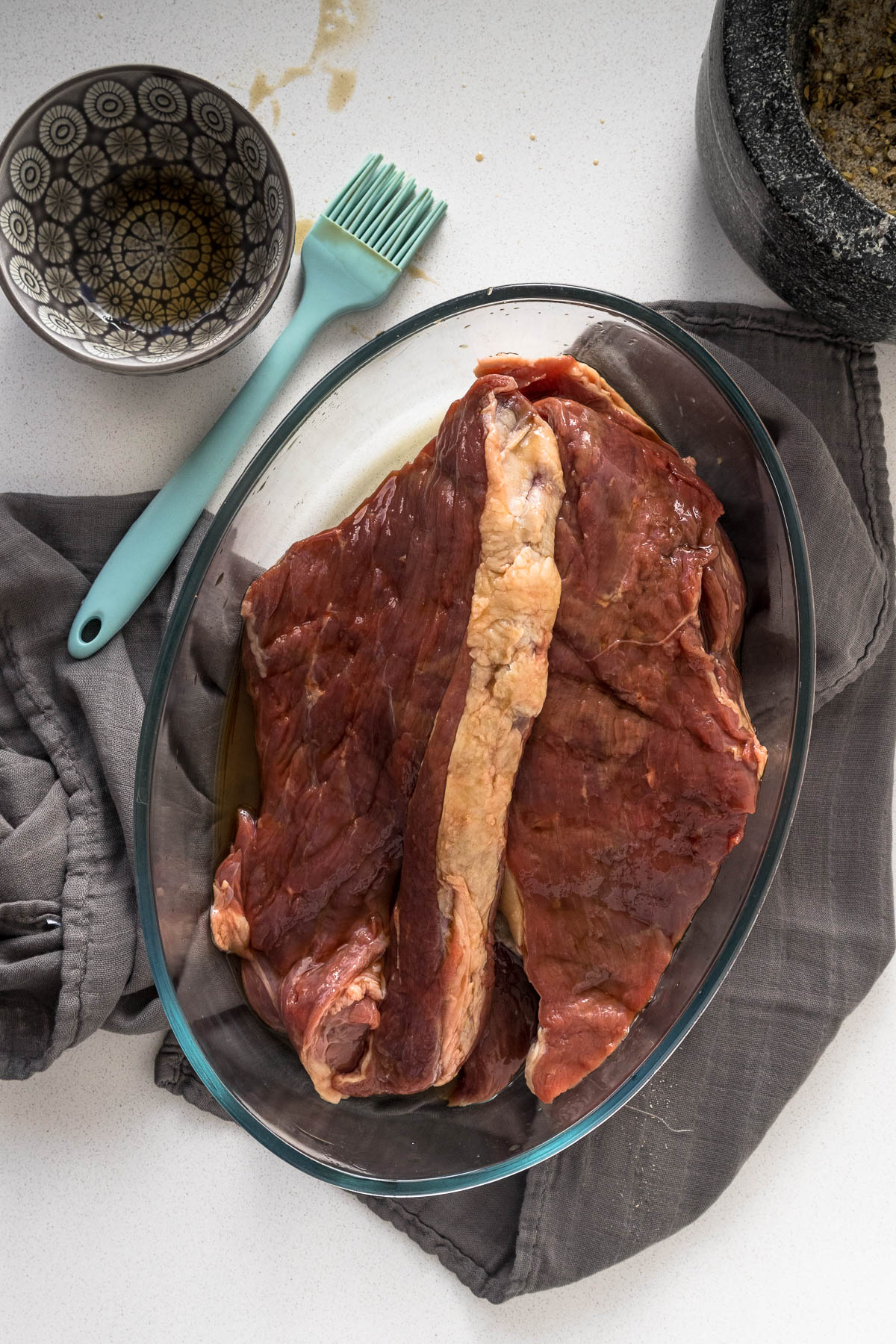
Step 5 - In a large glass dish, brush the vinegar mix onto all sides of the meat. Repeat for all the slices. Alternatively, place the meat into the container, pour over the vinegar mix and flip the meat around in the vinegar until all sides have been coated.
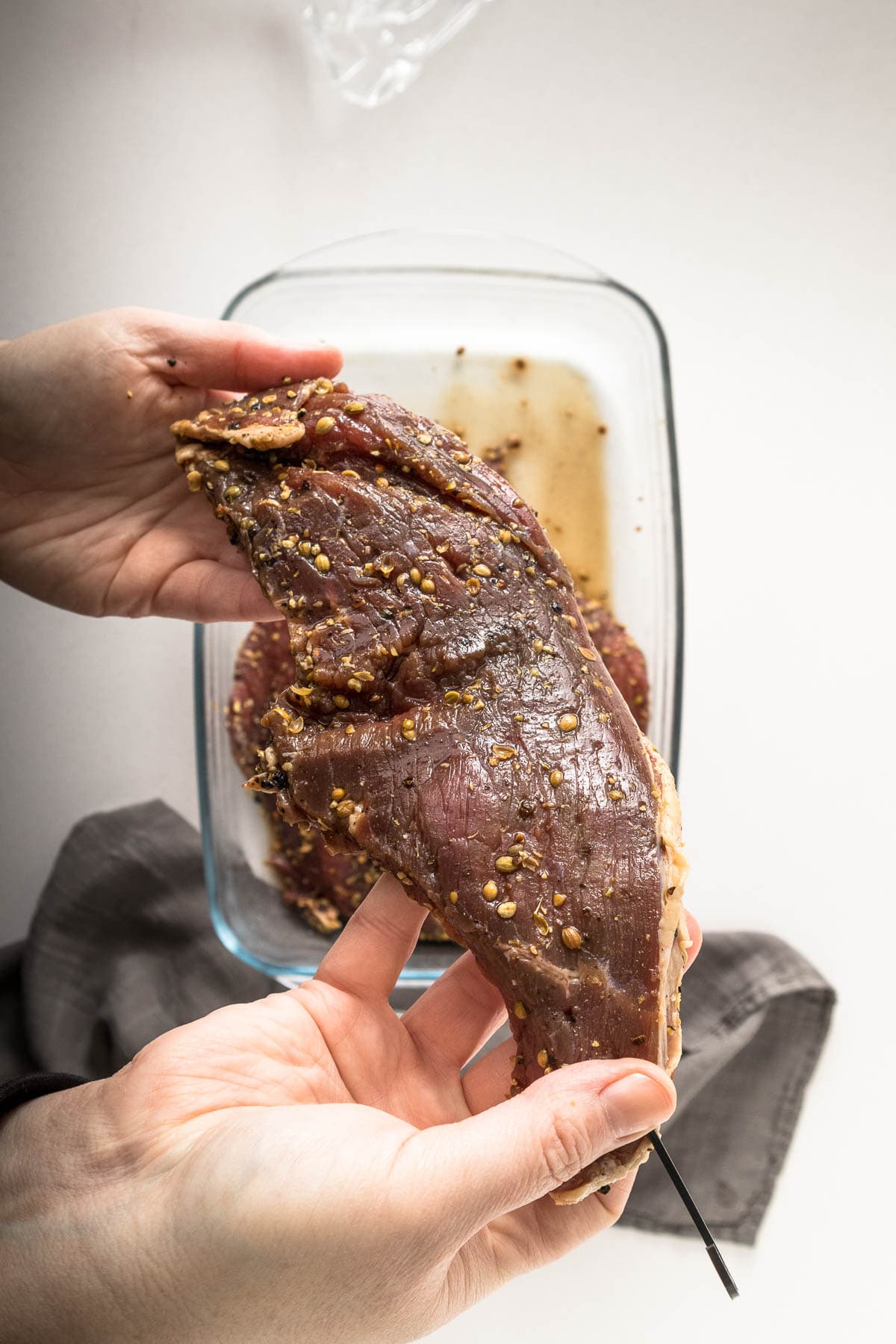
Step 6 - Sprinkle the meat with the coriander mix on all sides. Cover the glass dish in cling film or plastic wrap. Place in the fridge for 24 hours. The meat can be flipped over at the 12-hour mark.
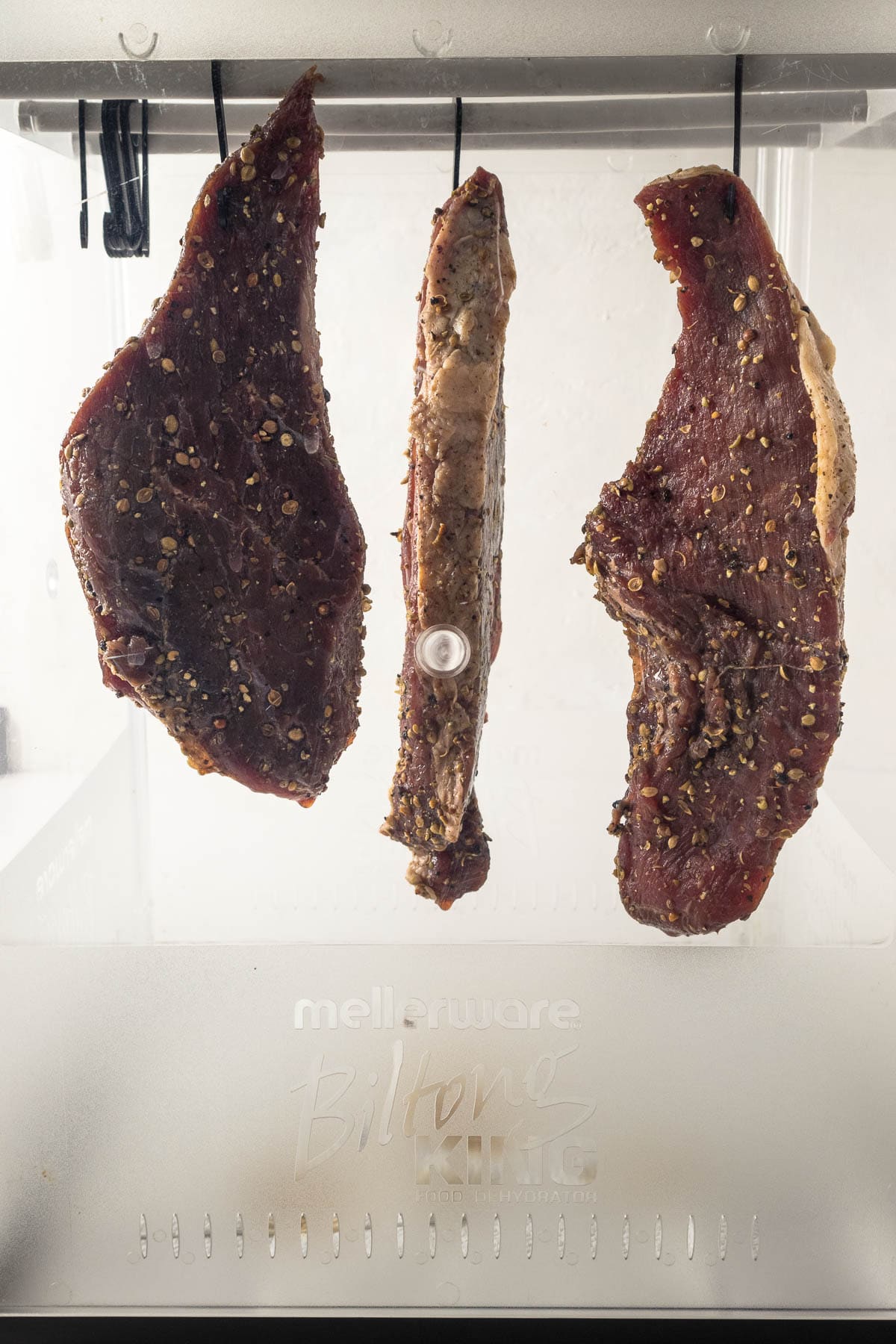
Step 7 - Set up the biltong box. I like to line the bottom with baking paper and a paper towel to catch and absorb juices that may drip off. Place a hook into each piece of the meat and hang it to dry in the box for 2 - 7 days, depending on how dry your want the biltong.
NOTE - Roughly 2 days for soft, wetter biltong, about 3-5 days for medium, and 4-7 days for drier biltong. You may need to experiment with your particular setup. Really thick pieces may take up to 2 weeks to be ready.
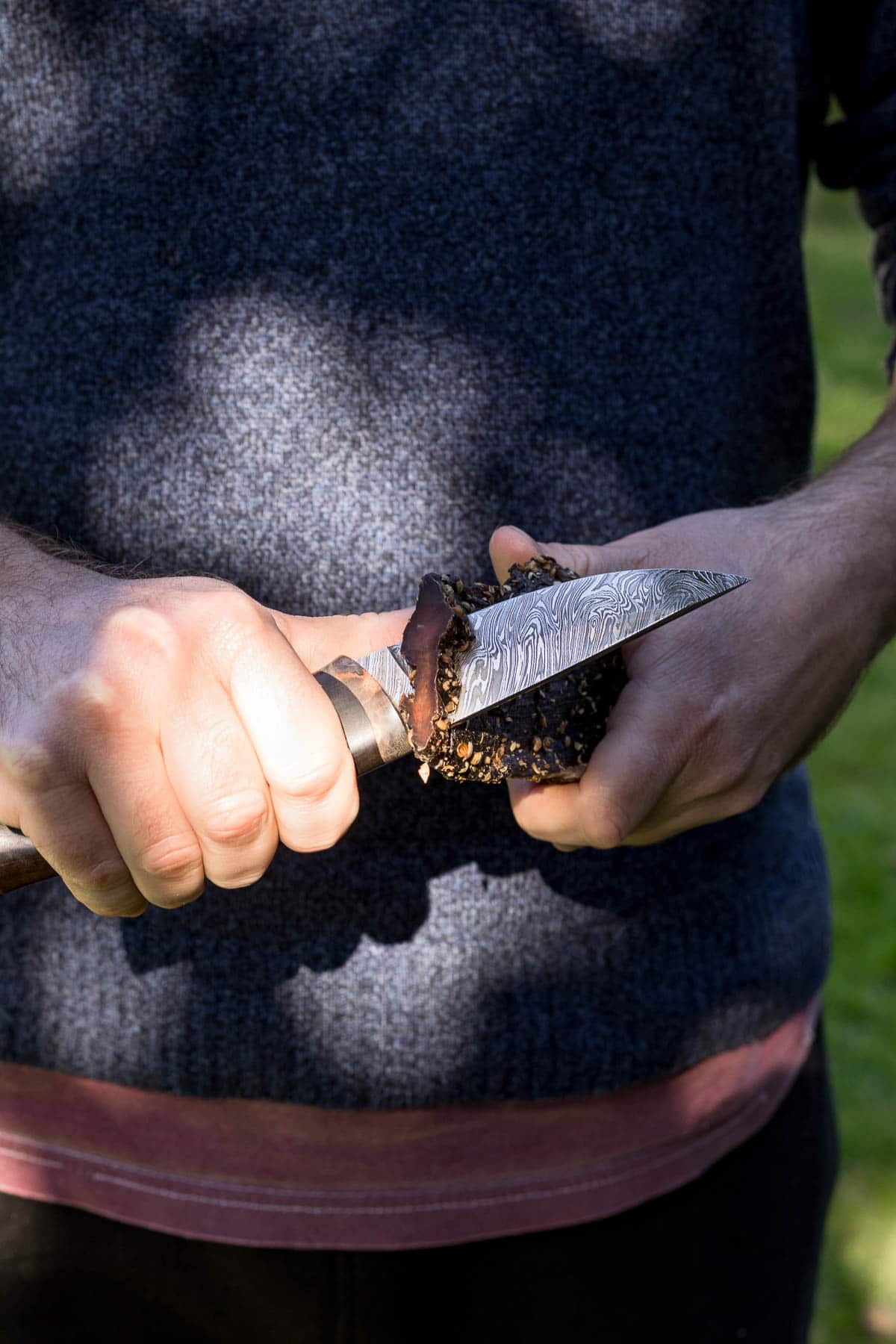
Making Biltong in a Dehydrator
We decided to do a test run of biltong in the dehydrator as an alternative to the cabinet.
We have the Ezidri Home Dehydrator, which means we were limited in the thickness of the biltong we could make. And cut the meat slices about 1.5-2cm thick and about 10cm long.
Basically, follow steps 1 - 6, taking into consideration how thick and long to cut the meat to fit into your particular dehydrator.
Step 7 - set up the dehydrator on the lowest heat setting (our dehydrator at the lowest setting was about 35°C/95F, place the meat in the dehydrator and run the dehydrator for 24 to 72 hours.
NOTE - If you can place thicker pieces of meat on your dehydrator trays, you may need to run the dehydrator for up to a week at the lowest temperature setting. Just like when using a biltong box, you may need to experiment with your setup for the best outcomes.
A Note on Humidity and Mould
When the weather is warm and humid, there is a chance that mould (white dots or furry dots) will appear on the meat. This is why it is important to check on the progress of the biltong every single day.
At the first sign of mould, take a clean cloth or pastry brush and dab and wipe off the mould. All the specks of mould need to be removed or the mould will spread again.
However, if you notice that the mould has spread and covered most of the biltong, it will need to be discarded and thrown away.
A word of caution - we live in Christchurch, New Zealand, where it is fairly humid most of the year. We switched off our box for 24 hours in one of our test batches, but left the meat hanging and the very next day we saw specks of mould all over! Consider that a lesson learnt!
A Note on Air Flow
Too much airflow will result in a thick, hard casing (black portion or ring around the biltong). This means that the middle of the portion of the meat may not be able to dry out. Test your product by slicing off the bottom, if the casing is hard and the middle is too wet, the airflow needs to be turned down.
Storage and Freezing
Bilting should be stored in a well-aerated cool, dry area as whole pieces. Sliced or cut biltong must be stored in paper bags, in the fridge. This allows the moisture to be removed which prevents mould.
How long can I store biltong? Well, in my house I have never seen biltong last longer than a week! Because it's just too delicious. However, in a cool, dry environment it should last 4 to 6 days before mould begins to appear. This is dependent not only on how the biltong is but the environment in which it is stored.
Use your best judgement!
Pin for Later
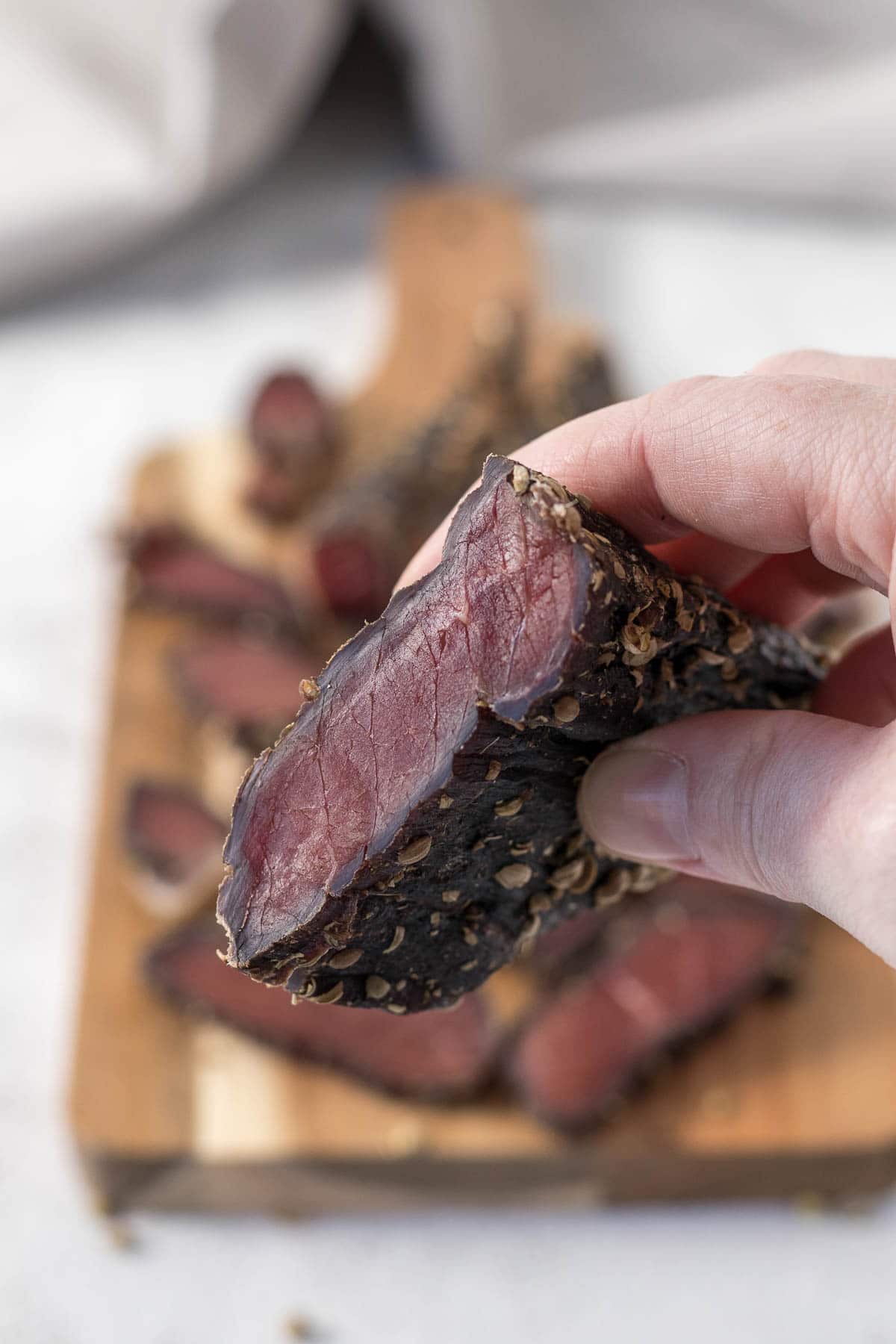
Rate & Review!
If you made this recipe, please leave a star rating! It gives my readers and me helpful feedback. If you want more recipes, subscribe to my newsletter, and follow me on Instagram, Pinterest, and Facebook!
Recipe Card
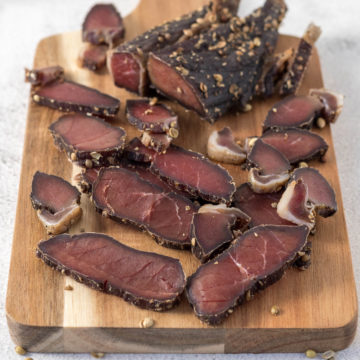
Biltong
Equipment
- Biltong Box or Dehydrator
- Mortar and Pestle or Spice Grinder
Ingredients
- 1 kg Beef Round Rump, Silverside, Topside
- 1½ tablespoons Coriander
- 1½-2½ teaspoons Peppercorns (depends on personal spiciness level)
- 25 grams sea salt (aim for 2.25-2.5% salt w/w)
- 2½ tablespoons vinegar (malt or red wine)
- 2½ teaspoons brown sugar
- 1 tablespoon Worchestershire Sauce
Instructions
- Toast the coriander and black pepper until browning, fragrant and smoking a tiny bit in a dry pan.1½ tablespoons Coriander, 1½-2½ teaspoons Peppercorns
- Place the coriander, pepper and sea salt into a mortar and pestle and grind until about 50% of the coriander, and black pepper are mostly powder-like. Set aside.1½ tablespoons Coriander, 1½-2½ teaspoons Peppercorns, 25 grams sea salt
- In a small bowl, combine the vinegar, Worcestershire sauce and sugar. Stir until the sugar has dissolved. Set aside.2½ tablespoons vinegar, 2½ teaspoons brown sugar, 1 tablespoon Worchestershire Sauce
- Cut the meat along the grain into 3cm thick strips1 kg Beef Round
- In a large glass dish, brush the vinegar mix onto all sides of the meat. Repeat for all the slices. Alternatively, place the meat into the container, pour over the vinegar mix and flip the meat around in the vinegar until all sides have been coated.
- Sprinkle the meat with the coriander mix on all sides. Cover the glass dish in cling film or plastic wrap. Place in the fridge for 24 hours. The meat can be flipped over at the 12-hour mark.
- Set up the biltong box. I like to line the bottom with baking paper and a paper towel to catch and absorb juices that may drip off. Place a hook into each piece of the meat and hang it to dry in the box for 2 - 7 days, depending on how dry your want the biltong.
Notes
Nutrition
Nutrition information is an estimate. If scaling the recipe remember to scale your cook and bakeware accordingly. All temperatures stated are conventional, unless otherwise stated. Recipes tested in grams and at sea level.

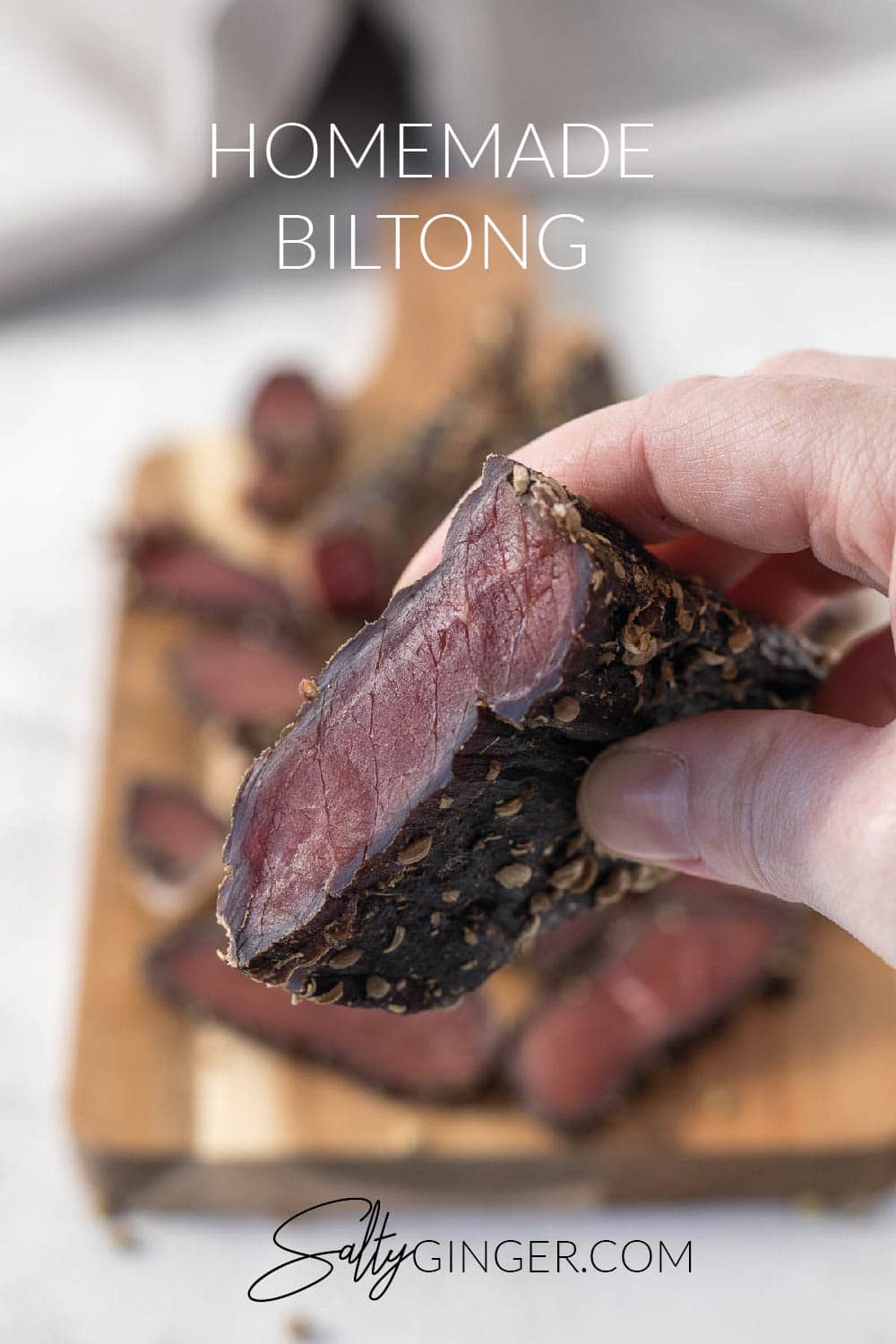
Luke Rathbone says
Nice recipe guys. If you find yourself in Australia I'd recommend checking out this, biltong too.
Vanessa says
Yours was the first article that came up when I searched up biltong on pinterest, and it was perfect! I've just ordered my SA husband a biltong cabinet for Christmas - a Mellerware one, so that seemed like a good sign that your instructions would be suitable - then as I read further I see you're in NZ, which is great as I should be able to easily source all of the ingredients you mention...and you're I Christchurch, and I'm just an hour out from there, so the climate conditions are similar!! I don't think I need to look any further for a how-to-guide that I can use! Instead I'll look at your other recipes - the biltong cabinet isn't a surprise gift, but maybe I can make one of the dishes my husband talks about as a Christmas Day surprise. Thanks for such an easy to follow (and personally relevant!) guide on making biltong.
Mary-Lou says
Hi Vanessa,
Thank you for your amazing comment on this post.
The Mellerware biltong king is a great present! And I'm so glad you are going to try your hand at biltong. It's crazy how small the world is sometimes, to think I am so so close to where your biltong magic will be happening. I think the biggest challenge we had here in Chch was definitely the humidity, so keep an eye out.
I like the idea of a surprise Christmas Dish for your husband...hopefully there is something on here that will please his tastebuds!
Let me know how it all goes down. Happy Biltong Making!